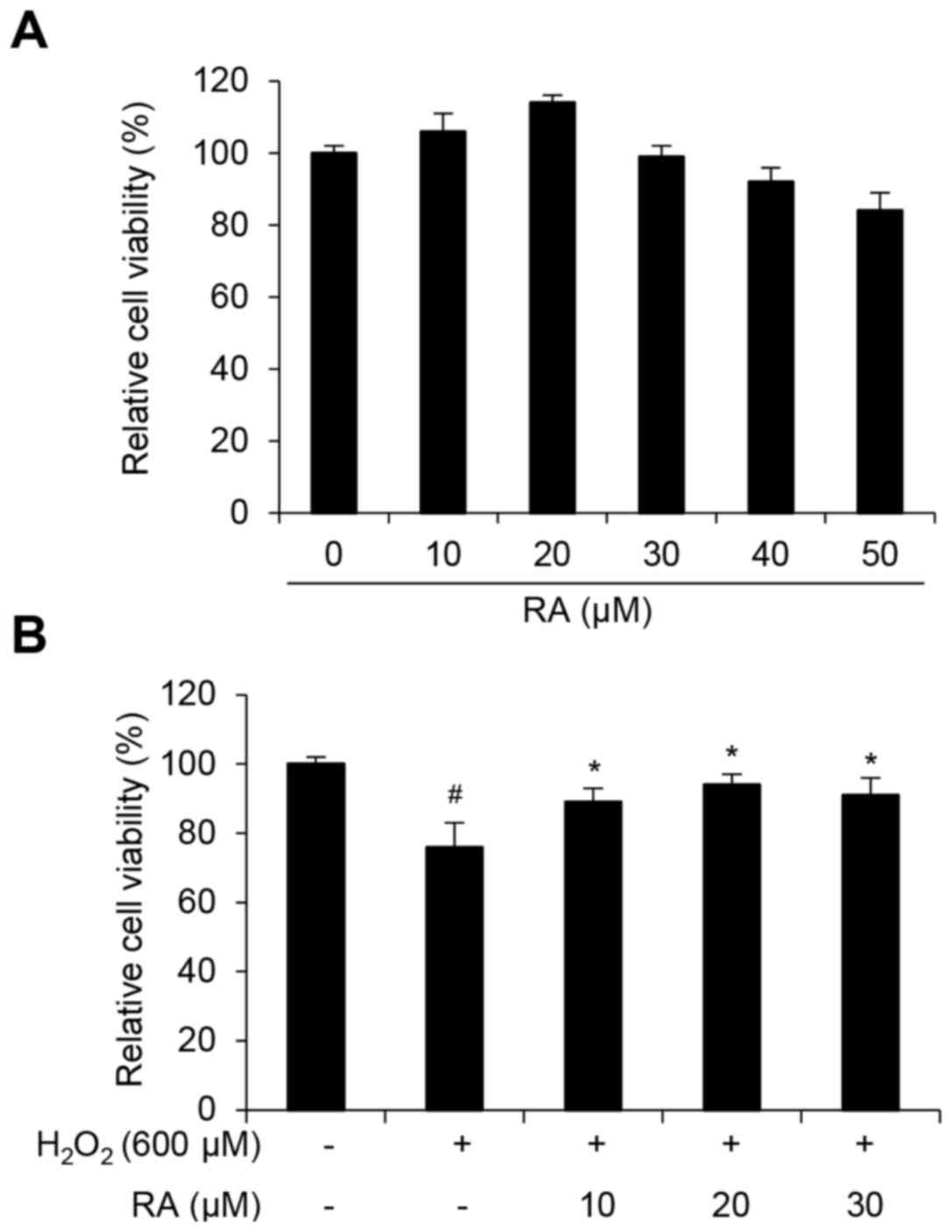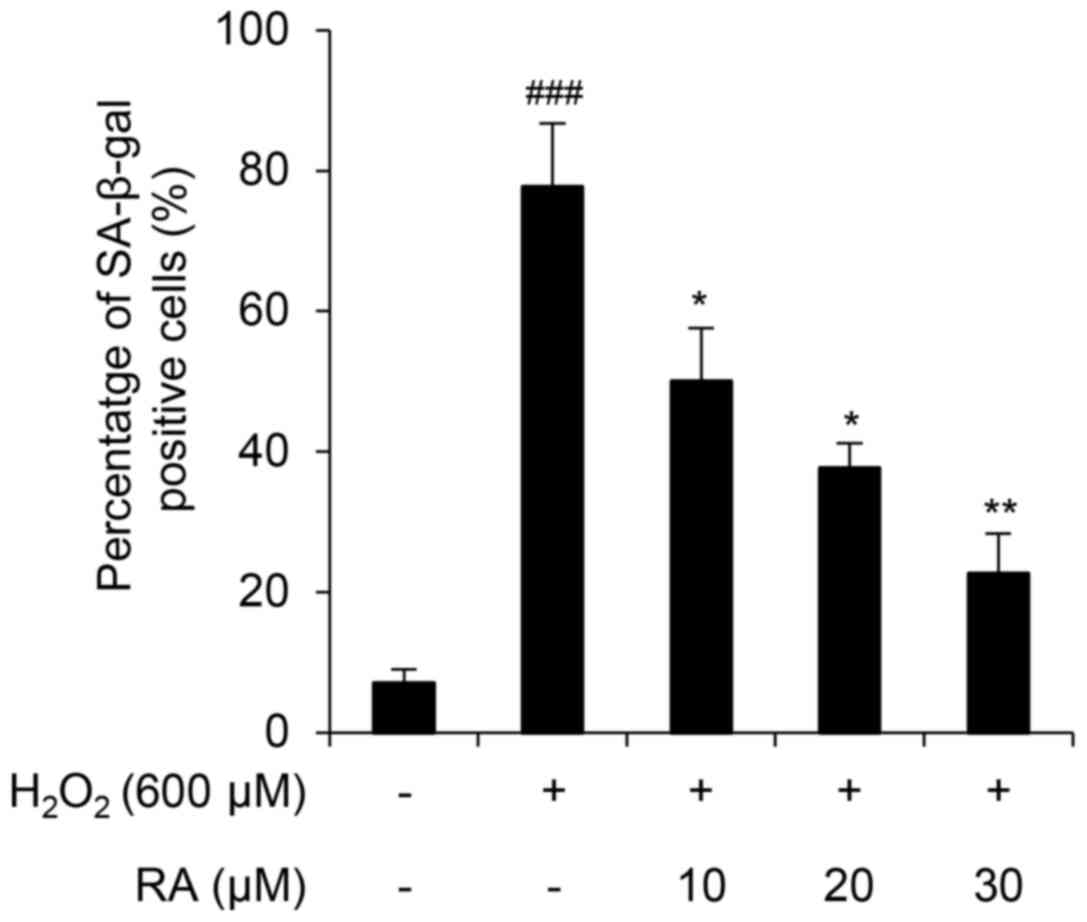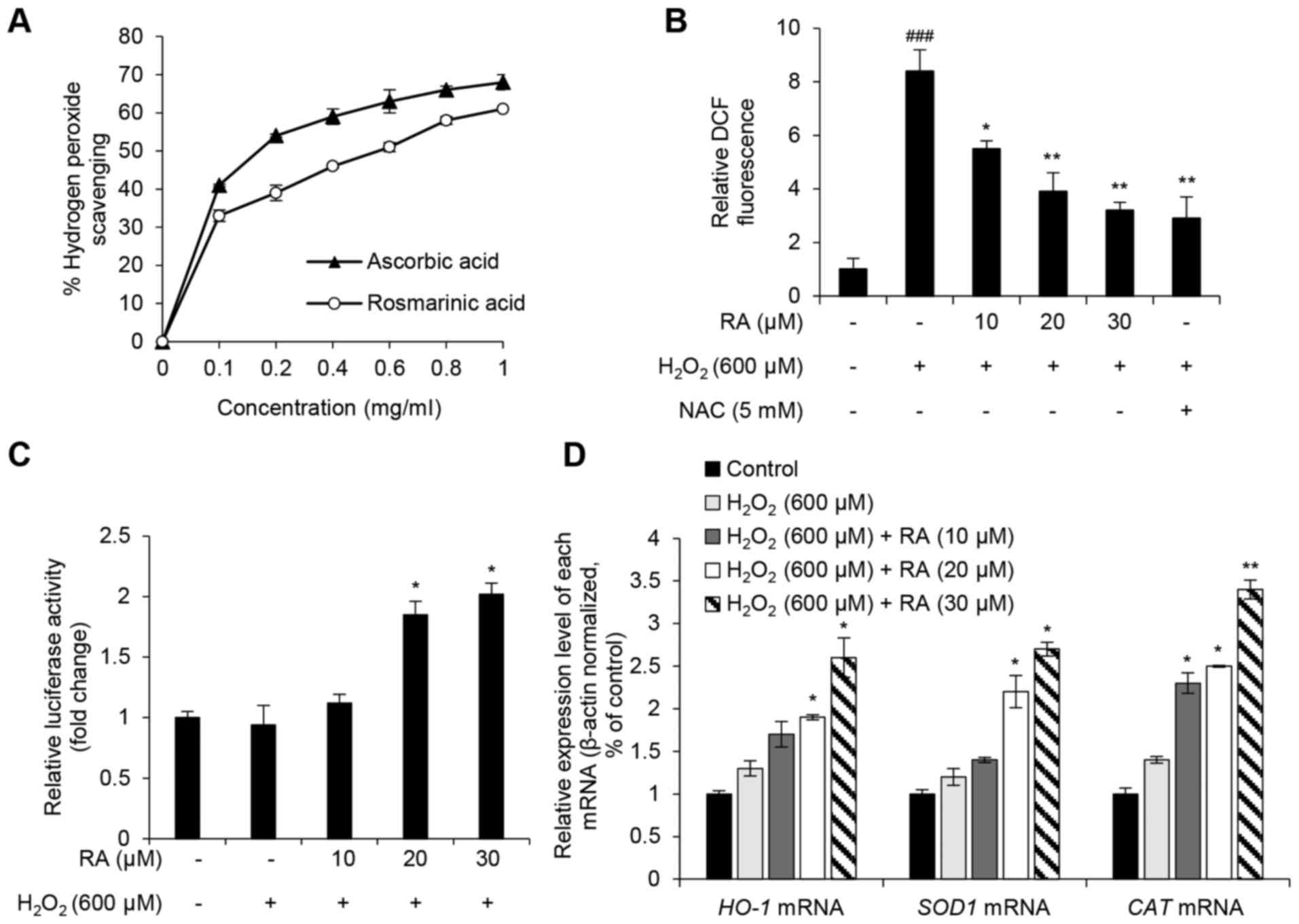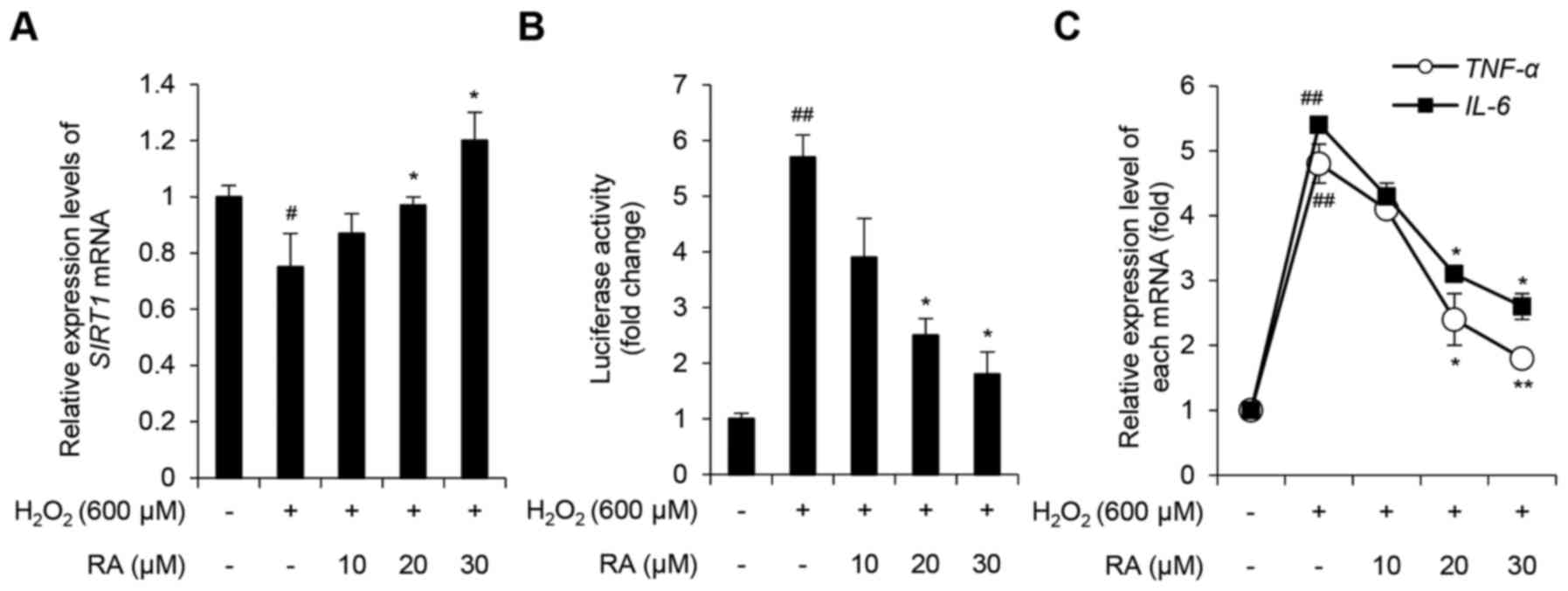|
1
|
Poljsak B, Dahmane RG and Godić A:
Intrinsic skin aging: The role of oxidative stress. Acta
Dermatovenerol Alp Pannonica Adriat. 21:33–36. 2012.PubMed/NCBI
|
|
2
|
Ganceviciene R, Liakou AI, Theodoridis A,
Makrantonaki E and Zouboulis CC: Skin anti-aging strategies.
Dermatoendocrinol. 4:308–319. 2012. View Article : Google Scholar : PubMed/NCBI
|
|
3
|
Davalli P, Mitic T, Caporali A, Lauriola A
and D'Arca D: ROS, cell senescence, and novel molecular mechanisms
in aging and age-related diseases. Oxid Med Cell Longev.
2016:35651272016. View Article : Google Scholar : PubMed/NCBI
|
|
4
|
Kansanen E, Kuosmanen SM, Leinonen H and
Levonen AL: The Keap1-Nrf2 pathway: Mechanisms of activation and
dysregulation in cancer. Redox Biol. 1:45–49. 2013. View Article : Google Scholar : PubMed/NCBI
|
|
5
|
Kensler TW, Wakabayashi N and Biswal S:
Cell survival responses to environmental stresses via the
Keap1-Nrf2-ARE pathway. Annu Rev Pharmacol Toxicol. 47:89–116.
2007. View Article : Google Scholar : PubMed/NCBI
|
|
6
|
Itoh K, Chiba T, Takahashi S, Ishii T,
Igarashi K, Katoh Y, Oyake T, Hayashi N, Satoh K, Hatayama I, et
al: An Nrf2/small Maf heterodimer mediates the induction of phase
II detoxifying enzyme genes through antioxidant response elements.
Biochem Biophys Res Commun. 236:313–322. 1997. View Article : Google Scholar : PubMed/NCBI
|
|
7
|
Buendia I, Michalska P, Navarro E, Gameiro
I, Egea J and Leon R: Nrf2-ARE pathway: An emerging target against
oxidative stress and neuroinflammation in neurodegenerative
diseases. Pharmacol Ther. 157:84–104. 2016. View Article : Google Scholar : PubMed/NCBI
|
|
8
|
Luo J, Nikolaev AY, Imai S, Chen D, Su F,
Shiloh A, Guarente L and Gu W: Negative control of p53 by Sir2alpha
promotes cell survival under stress. Cell. 107:137–148. 2001.
View Article : Google Scholar : PubMed/NCBI
|
|
9
|
Vaziri H, Dessain SK, Ng Eaton E, Imai SI,
Frye RA, Pandita TK, Guarente L and Weinberg RA: hSIR2(SIRT1)
functions as an NAD-dependent p53 deacetylase. Cell. 107:149–159.
2001. View Article : Google Scholar : PubMed/NCBI
|
|
10
|
Wu A, Ying Z and Gomez-Pinilla F:
Oxidative stress modulates Sir2alpha in rat hippocampus and
cerebral cortex. Eur J Neurosci. 23:2573–2580. 2006. View Article : Google Scholar : PubMed/NCBI
|
|
11
|
Moon MH, Jeong JK, Lee YJ, Seol JW,
Jackson CJ and Park SY: SIRT1, a class III histone deacetylase,
regulates TNF-α-induced inflammation in human chondrocytes.
Osteoarthritis Cartilage. 21:470–480. 2013. View Article : Google Scholar : PubMed/NCBI
|
|
12
|
Takayama K, Ishida K, Matsushita T, Fujita
N, Hayashi S, Sasaki K, Tei K, Kubo S, Matsumoto T and Fujioka H:
SIRT1 regulation of apoptosis of human chondrocytes. Arthritis
Rheum. 60:2731–2740. 2009. View Article : Google Scholar : PubMed/NCBI
|
|
13
|
Salminen A, Kauppinen A, Suuronen T and
Kaarniranta K: SIRT1 longevity factor suppresses NF-kappaB-driven
immune responses: Regulation of aging via NF-kappaB acetylation?
Bioessays. 30:939–942. 2008. View Article : Google Scholar : PubMed/NCBI
|
|
14
|
Balistreri CR, Candore G, Accardi G,
Colonna-Romano G and Lio D: NF-κB pathway activators as potential
ageing biomarkers: Targets for new therapeutic strategies. Immun
Ageing. 10:242013. View Article : Google Scholar : PubMed/NCBI
|
|
15
|
Tilstra JS, Clauson CL, Niedernhofer LJ
and Robbins PD: NF-κB in Aging and Disease. Aging Dis. 2:449–465.
2011.PubMed/NCBI
|
|
16
|
Tak PP and Firestein GS: NF-kappaB: A key
role in inflammatory diseases. J Clin Invest. 107:7–11. 2001.
View Article : Google Scholar : PubMed/NCBI
|
|
17
|
Vladimir-Knezevic S, Blazekovic B, Kindl
M, Vladic J, Lower-Nedza AD and Brantner AH: Acetylcholinesterase
inhibitory, antioxidant and phytochemical properties of selected
medicinal plants of the Lamiaceae family. Molecules. 19:767–782.
2014. View Article : Google Scholar : PubMed/NCBI
|
|
18
|
Jang AH, Kim TH, Kim GD, Kim JE, Kim HJ,
Kim SS, Jin YH, Park YS and Park CS: Rosmarinic acid attenuates
2,4-dinitrofluorobenzene-induced atopic dermatitis in NC/Nga mice.
Int Immunopharmacol. 11:1271–1277. 2011. View Article : Google Scholar : PubMed/NCBI
|
|
19
|
Karthik D, Viswanathan P and Anuradha CV:
Administration of rosmarinic acid reduces cardiopathology and blood
pressure through inhibition of p22phox NADPH oxidase in
fructose-fed hypertensive rats. J Cardiovasc Pharmacol. 58:514–521.
2011. View Article : Google Scholar : PubMed/NCBI
|
|
20
|
Kim GD, Park YS, Jin YH and Park CS:
Production and applications of rosmarinic acid and structurally
related compounds. Appl Microbiol Biotechnol. 99:2083–2092. 2015.
View Article : Google Scholar : PubMed/NCBI
|
|
21
|
Khojasteh A, Mirjalili MH, Hidalgo D,
Corchete P and Palazon J: New trends in biotechnological production
of rosmarinic acid. Biotechnol Lett. 36:2393–2406. 2014. View Article : Google Scholar : PubMed/NCBI
|
|
22
|
Sanchez-Campillo M, Gabaldon JA, Castillo
J, Benavente-García O, Del Baño MJ, Alcaraz M, Vicente V, Alvarez N
and Lozano JA: Rosmarinic acid, a photo-protective agent against UV
and other ionizing radiations. Food Chem Toxicol. 47:386–392. 2009.
View Article : Google Scholar : PubMed/NCBI
|
|
23
|
Yoo SM and Kang JR: Antioxidation effects
of rosmarinic acid on human skin melanoma cells treated with
hydrogen peroxide. J Korean Soc Appl Bi. 52:247–251. 2009.
View Article : Google Scholar
|
|
24
|
Fernando PM, Piao MJ, Kang KA, Ryu YS,
Hewage SR, Chae SW and Hyun JW: Rosmarinic acid attenuates cell
damage against UVB radiation-induced oxidative stress via enhancing
antioxidant effects in human HaCaT cells. Biomol Ther (Seoul).
24:75–84. 2016. View Article : Google Scholar : PubMed/NCBI
|
|
25
|
Vostálová J, Zdarilová A and Svobodová A:
Prunella vulgaris extract and rosmarinic acid prevent UVB-induced
DNA damage and oxidative stress in HaCaT keratinocytes. Arch
Dermatol Res. 302:171–181. 2010. View Article : Google Scholar : PubMed/NCBI
|
|
26
|
Oyedemi SO, Bradley G and Afolayan AJ:
In-vitro and -vivo antioxidant activities of aqueous extract of
Strychnos henningsii Gilg. Afr J Pharm Pharmaco. 4:70–78. 2010.
|
|
27
|
Martinez-Outschoorn UE, Trimmer C, Lin Z,
Whitaker-Menezes D, Chiavarina B, Zhou J, Wang C, Pavlides S,
Martinez-Cantarin MP, Capozza F, et al: Autophagy in cancer
associated fibroblasts promotes tumor cell survival: Role of
hypoxia, HIF1 induction and NFκB activation in the tumor stromal
microenvironment. Cell Cycle. 9:3515–3533. 2010. View Article : Google Scholar : PubMed/NCBI
|
|
28
|
Debacq-Chainiaux F, Erusalimsky JD,
Campisi J and Toussaint O: Protocols to detect
senescence-associated beta-galactosidase (SA-betagal) activity, a
biomarker of senescent cells in culture and in vivo. Nat Protoc.
4:1798–1806. 2009. View Article : Google Scholar : PubMed/NCBI
|
|
29
|
Livak KJ and Schmittgen TD: Analysis of
relative gene expression data using real-time quantitative PCR and
the 2(-Delta Delta C(T)) method. Methods. 25:402–408. 2001.
View Article : Google Scholar : PubMed/NCBI
|
|
30
|
Martindale JL and Holbrook NJ: Cellular
response to oxidative stress: Signaling for suicide and survival. J
Cell Physiol. 192:1–15. 2002. View Article : Google Scholar : PubMed/NCBI
|
|
31
|
Korycka-Dahl MB and Richardson T:
Activated oxygen species and oxidation of food constituents. CRC
Crit Rev Food Sci Nutr. 10:209–241. 1978. View Article : Google Scholar : PubMed/NCBI
|
|
32
|
Halliwell B and Gutteridge JM: Oxygen free
radicals and iron in relation to biology and medicine: Some
problems and concepts. Arch Biochem Biophys. 246:501–514. 1986.
View Article : Google Scholar : PubMed/NCBI
|
|
33
|
Simon HU, Haj-Yehia A and Levi-Schaffer F:
Role of reactive oxygen species (ROS) in apoptosis induction.
Apoptosis. 5:415–418. 2000. View Article : Google Scholar : PubMed/NCBI
|
|
34
|
Yeung F, Hoberg JE, Ramsey CS, Keller MD,
Jones DR, Frye RA and Mayo MW: Modulation of NF-kappaB-dependent
transcription and cell survival by the SIRT1 deacetylase. EMBO J.
23:2369–2380. 2004. View Article : Google Scholar : PubMed/NCBI
|
|
35
|
Ou X, Lee MR, Huang X, Messina-Graham S
and Broxmeyer HE: SIRT1 positively regulates autophagy and
mitochondria function in embryonic stem cells under oxidative
stress. Stem Cells. 32:1183–1194. 2014. View Article : Google Scholar : PubMed/NCBI
|
|
36
|
Huo Y, Qiu WY, Pan Q, Yao YF, Xing K and
Lou MF: Reactive oxygen species (ROS) are essential mediators in
epidermal growth factor (EGF)-stimulated corneal epithelial cell
proliferation, adhesion, migration, and wound healing. Exp Eye Res.
89:876–886. 2009. View Article : Google Scholar : PubMed/NCBI
|
|
37
|
Shi HX, Cheng Y, Ye JJ, Cai P, Zhang J, Li
R, Yang Y, Wang Z, Zhang H, Lin C, et al: bFGF promotes the
migration of human dermal fibroblasts under diabetic conditions
through reactive oxygen species production via the
PI3K/Akt-Rac1-JNK pathways. Int J Biol Sci. 11:845–859. 2015.
View Article : Google Scholar : PubMed/NCBI
|
|
38
|
Farris P, Yatskayer M, Chen N, Krol Y and
Oresajo C: Evaluation of efficacy and tolerance of a nighttime
topical antioxidant containing resveratrol, baicalin, and vitamin e
for treatment of mild to moderately photodamaged skin. J Drugs
Dermatol. 13:1467–1472. 2014.PubMed/NCBI
|
|
39
|
Peus D, Vasa RA, Meves A, Pott M, Beyerle
A, Squillace K and Pittelkow MR: H2O2 is an
important mediator of UVB-induced EGF-receptor phosphorylation in
cultured keratinocytes. J Invest Dermatol. 110:966–971. 1998.
View Article : Google Scholar : PubMed/NCBI
|
|
40
|
Gilchrest BA: Skin aging and photoaging:
An overview. J Am Acad Dermatol. 21:610–613. 1989. View Article : Google Scholar : PubMed/NCBI
|
|
41
|
Shin MH, Rhie GE, Kim YK, Park CH, Cho KH,
Kim KH, Eun HC and Chung JH: H2O2
accumulation by catalase reduction changes MAP kinase signaling in
aged human skin in vivo. J Invest Dermatol. 125:221–229. 2005.
View Article : Google Scholar : PubMed/NCBI
|
|
42
|
Lee BY, Han JA, Im JS, Morrone A, Johung
K, Goodwin EC, Kleijer WJ, DiMaio D and Hwang ES:
Senescence-associated beta-galactosidase is lysosomal
beta-galactosidase. Aging Cell. 5:187–195. 2006. View Article : Google Scholar : PubMed/NCBI
|
|
43
|
Marionnet C, Pierrard C, Lejeune F, Sok J,
Thomas M and Bernerd F: Different oxidative stress response in
keratinocytes and fibroblasts of reconstructed skin exposed to non
extreme daily-ultraviolet radiation. PLoS One. 5:e120592010.
View Article : Google Scholar : PubMed/NCBI
|
|
44
|
Tao S, Justiniano R, Zhang DD and Wondrak
GT: The Nrf2-inducers tanshinone I and dihydrotanshinone protect
human skin cells and reconstructed human skin against solar
simulated UV. Redox Biol. 1:532–541. 2013. View Article : Google Scholar : PubMed/NCBI
|
|
45
|
Saw CL, Yang AY, Huang MT, Liu Y, Lee JH,
Khor TO, Su ZY, Shu L, Lu Y, Conney AH and Kong AN: Nrf2 null
enhances UVB-induced skin inflammation and extracellular matrix
damages. Cell Biosci. 4:392014. View Article : Google Scholar : PubMed/NCBI
|
|
46
|
Panich U, Sittithumcharee G, Rathviboon N
and Jirawatnotai S: Ultraviolet radiation-induced skin aging: The
role of DNA damage and oxidative stress in epidermal stem cell
damage mediated skin aging. Stem Cells Int. 2016:73706422016.
View Article : Google Scholar : PubMed/NCBI
|
|
47
|
Wagener FA, Carels CE and Lundvig DM:
Targeting the redox balance in inflammatory skin conditions. Int J
Mol Sci. 14:9126–9167. 2013. View Article : Google Scholar : PubMed/NCBI
|
|
48
|
Rahman I, Kinnula VL, Gorbunova V and Yao
H: SIRT1 as a therapeutic target in inflammaging of the pulmonary
disease. Prev Med. 54 Suppl:S20–S28. 2012. View Article : Google Scholar : PubMed/NCBI
|
|
49
|
Yao H and Rahman I: Perspectives on
translational and therapeutic aspects of SIRT1 in inflammaging and
senescence. Biochem Pharmacol. 84:1332–1339. 2012. View Article : Google Scholar : PubMed/NCBI
|


















